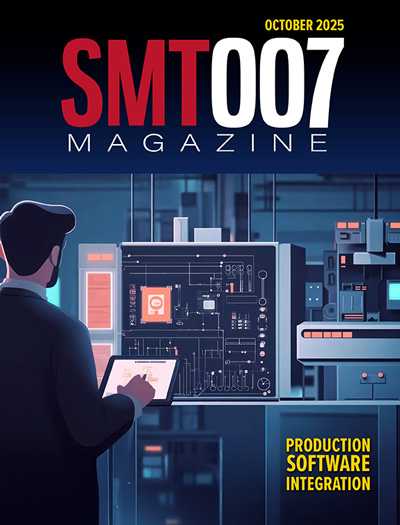-

- News
- Books
Featured Books
- smt007 Magazine
Latest Issues
Current Issue
Spotlight on Mexico
Mexico isn’t just part of the electronics manufacturing conversation—it’s leading it. From growing investments to cross-border collaborations, Mexico is fast becoming the center of electronics in North America. This issue includes bilingual content, with all feature articles available in both English and Spanish.

Production Software Integration
EMS companies need advanced software systems to thrive and compete. But these systems require significant effort to integrate and deploy. What is the reality, and how can we make it easier for everyone?

Spotlight on India
We invite you on a virtual tour of India’s thriving ecosystem, guided by the Global Electronics Association’s India office staff, who share their insights into the region’s growth and opportunities.
- Articles
- Columns
- Links
- Media kit
||| MENU - smt007 Magazine
How CIM and IoT Can Make Your Factory Smart
October 12, 2018 | Zac Elliott, Mentor, A Siemens BusinessEstimated reading time: 7 minutes
Abstract
With so many extremely clever scientists and engineers in our industry, the whole complex technology of electronics assembly requires people with specialist skills. When it comes to linking all these processes together, there is more than just a simple data connection to think about. The content of data from the myriad of different processes and technologies firstly needs to be understood and then needs to be transformed into information which is then actionable, not just by a human, but by a computer.
There is no one person who can understand every aspect of every process, and every opportunity for smart factory functionality. Accessibility to new IoT manufacturing data connections is a multi-way technology. As well as higher level systems such as the manufacturing execution system (MES) or enterprise resource planning (ERP) systems making smarter decisions, the same IoT data is also available to every machine vendor, each of whom know their technology down to the finest detail. Here is where we will see the bulk of the smart solutions for assembly manufacturing coming from.
Driving this is the machine vendor agnostic data acquisition and utilization, with complementary functionality through machine, line, factory and enterprise levels. This promotes healthy differentiation between vendors in the same market space, not only in terms of machine performance, but also in terms of the smart solutions that they can provide based on the data collective.
This paper explores the changes in culture between the past, where data was simply sent point to point, and today’s multi-layered IoT technology-based solutions, as well as the effects and opportunities that are here now for the taking.
Introduction
To create smart factories capable of autonomous optimization of interconnected processes, it is necessary to integrate the myriad of disparate computer systems used in electronics manufacturing. Given the complexity and cost associated with this undertaking, the path to a smart factory may seem out of reach to all but the largest manufacturers. To enable the widespread adoption of smart factory functionality, it is therefore necessary to reduce the complexity, effort, and cost by defining a general approach to the smart factory infrastructure.
Industry Challenges
As business needs challenge the electronics assembly industry to support increased flexibility, lower overhead, and stricter quality standards, the industry is rapidly adopting improvements in automation and analytics to meet the challenge. The so-called smart factory and Industry 4.0 initiatives are aimed at further integrating manufacturing processes with business processes to autonomously and continuously optimize operations.
The unique challenge to the electronic assembly industry is the existing level of technical sophistication and automation presently used to manage the complex manufacturing process. Computer integrated manufacturing (CIM) systems are necessary to any electronics manufacturing operation. Many varied computer systems, automated robots, and technical experts work together not only to execute manufacturing but also to design streamlined processes, optimize the supply chain, and manage product quality. To begin linking these existing processes together can be an arduous task requiring a multidisciplinary team of technical process experts, product engineers, operational resources, and business process owners.
Although integration can be a complex and expensive proposition, there are tangible benefits to closely coupling the systems used to manage the equipment, the factory, and the enterprise. The ability to share information and control not only between individual equipment but also between equipment and business systems offers the ability to further automate and optimize sophisticated manufacturing processes.
Immediate Effects on Electronics Manufacturing
Considering the challenges facing the industry, electronic manufacturers will be seeking solutions that represent tangible progress toward the fundamentals of Industry 4.0 and the smart factory, namely autonomous, continuous optimization of operations. SMT equipment vendors have been the first to respond to the needs of the market by expanding the scope of their CIM systems beyond simply controlling the individual machine to managing the entire production line or other ancillary processes such as material management. Through partnerships with complimentary equipment vendors, entire end-to-end solutions can be offered to the market.
Although systems provided by the equipment vendor will be the optimal solution for their equipment platform and will begin to address the need for integrated, autonomous manufacturing, there is still significant complexity in connecting the web of business processes needed for most smart factory functions. Due to a variety of factors, many manufacturers have a mix of equipment vendors.
A given manufacturing site may have multiple SMT platforms and a broad range of third-party equipment platforms to support. To integrate and connect these heterogeneous environments with minimal complexity and cost, it is advantageous to define a generic approach to the smart factory.
Smart Factory Infrastructure
To define a more general infrastructure in which to work, the existing CIM applications can be grouped into the three primary layers that exist functionally: process applications, site applications, and enterprise applications. These groups of applications generally serve the same function in relation to each other, as shown in Figure 1.
Figure 1: Smart factory layers.
At the lowest layer are the process applications which control or manage a given manufacturing process. These are the machine vendor applications, programmable logic controllers (PLC), sensors, or custom applications that run equipment, collect data, or guide a person or process. These applications may create event data that is valuable to other processes or to the higher-level infrastructure. To operate, these applications generally require information from the higher-level infrastructure, such as material information, work orders, and flow control.
Sitting above the process-specific applications are the site applications that manage the overall manufacturing flow. The MES infrastructure, process engineering, quality management, material management, and finite production planning applications are typical site-level functions. In many cases, these applications are consuming the event data created by specific processes to actively manage production operation to operation. The site level applications provide the flow control, work order details, and material information required by the process-specific operations.
Page 1 of 2
Testimonial
"Your magazines are a great platform for people to exchange knowledge. Thank you for the work that you do."
Simon Khesin - Schmoll MaschinenSuggested Items
SEL Receives Purdue Senior Design Partner of the Year Award
05/01/2025 | Schweitzer Engineering LaboratoriesSchweitzer Engineering Laboratories (SEL) has been awarded the Senior Design Partner of the Year Award from the Edwardson School of Industrial Engineering at Purdue University.
A Look Into the Future With Futurist Kevin Surace
04/07/2025 | Barry Matties, I-Connect007In this interview after his keynote address at IPC APEX EXPO 2025, futurist Kevin Surace reflects on important lessons learned and how they shaped his own future. He also makes some bold predictions for the use of AI in PCB board design, fabrication, and assembly—and what the common household will look like in 10 years. It’s an exciting and adventurous step into a future where humans work alongside robots, all for the betterment of everyone.
Networking and Growth: Highlights from the IPC Emerging Engineer Reception
03/19/2025 | Marcy LaRont, I-Connect007It was my first day in Anaheim for IPC APEX EXPO, and I arrived at John Wayne airport on Saturday to cool and sunny weather, which, coming from Arizona, is my favorite. The show starts with technical and standards work over the weekend as we prep for the show floor opening in the days to come. Exhibitors and union workers get busy building the impressive booths that make up the exhibition, which started on Tuesday and saw a steady flow of attendees all day long.
Mind Meld: Brian Chislea and AJ Arriaga Share Their Fascinating Experience in IPC's Mentorship Program
01/28/2025 | Michelle Te, IPC CommunityIPC’s Emerging Engineer program provides professionals an opportunity early in their careers to learn from dedicated industry volunteers participating in standards development. Two participants in the program—Brian Chislea, Dow Chemical, mentor to AJ Arriaga, Summit Interconnect—share their experiences in the program in a series of articles. We will follow them through their three years in the mentorship. This is the first in the series.
'Qualcomm AI Program for Innovators' Launched to Foster On-Device AI Innovation in the Asia-Pacific Region
12/27/2024 | Qualcomm Technologies, Inc.Qualcomm Technologies, Inc. announced the launch of the Qualcomm AI Program for Innovators (QAIPI) 2025 - APAC, a new initiative aimed at supporting professional developers and startups from Japan, Singapore, and South Korea to create cutting-edge on-device AI solutions across diverse sectors.


